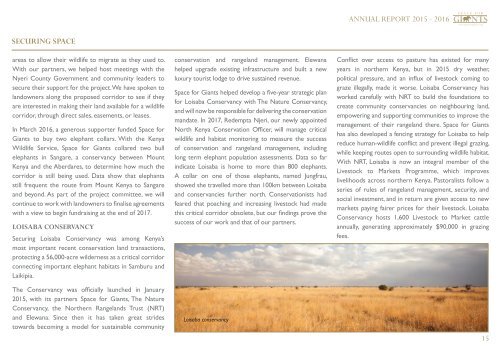2016SFGAR_PRINT11APRIL-LR
You also want an ePaper? Increase the reach of your titles
YUMPU automatically turns print PDFs into web optimized ePapers that Google loves.
ANNUAL REPORT 2015 - 2016<br />
www.spaceforgiants.org<br />
SECURING SPACE<br />
areas to allow their wildlife to migrate as they used to.<br />
With our partners, we helped host meetings with the<br />
Nyeri County Government and community leaders to<br />
secure their support for the project. We have spoken to<br />
landowners along the proposed corridor to see if they<br />
are interested in making their land available for a wildlife<br />
corridor, through direct sales, easements, or leases.<br />
In March 2016, a generous supporter funded Space for<br />
Giants to buy two elephant collars. With the Kenya<br />
Wildlife Service, Space for Giants collared two bull<br />
elephants in Sangare, a conservancy between Mount<br />
Kenya and the Aberdares, to determine how much the<br />
corridor is still being used. Data show that elephants<br />
still frequent the route from Mount Kenya to Sangare<br />
and beyond. As part of the project committee, we will<br />
continue to work with landowners to finalise agreements<br />
with a view to begin fundraising at the end of 2017.<br />
LOISABA CONSERVANCY<br />
Securing Loisaba Conservancy was among Kenya’s<br />
most important recent conservation land transactions,<br />
protecting a 56,000-acre wilderness as a critical corridor<br />
connecting important elephant habitats in Samburu and<br />
Laikipia.<br />
The Conservancy was officially launched in January<br />
2015, with its partners Space for Giants, The Nature<br />
Conservancy, the Northern Rangelands Trust (NRT)<br />
and Elewana. Since then it has taken great strides<br />
towards becoming a model for sustainable community<br />
conservation and rangeland management. Elewana<br />
helped upgrade existing infrastructure and built a new<br />
luxury tourist lodge to drive sustained revenue.<br />
Space for Giants helped develop a five-year strategic plan<br />
for Loisaba Conservancy with The Nature Conservancy,<br />
and will now be responsible for delivering the conservation<br />
mandate. In 2017, Redempta Njeri, our newly appointed<br />
North Kenya Conservation Officer, will manage critical<br />
wildlife and habitat monitoring to measure the success<br />
of conservation and rangeland management, including<br />
long term elephant population assessments. Data so far<br />
indicate Loisaba is home to more than 800 elephants.<br />
A collar on one of those elephants, named Jungfrau,<br />
showed she travelled more than 100km between Loisaba<br />
and conservancies further north. Conservationists had<br />
feared that poaching and increasing livestock had made<br />
this critical corridor obsolete, but our findings prove the<br />
success of our work and that of our partners.<br />
Loisaba conservancy<br />
Conflict over access to pasture has existed for many<br />
years in northern Kenya, but in 2015 dry weather,<br />
political pressure, and an influx of livestock coming to<br />
graze illegally, made it worse. Loisaba Conservancy has<br />
worked carefully with NRT to build the foundations to<br />
create community conservancies on neighbouring land,<br />
empowering and supporting communities to improve the<br />
management of their rangeland there. Space for Giants<br />
has also developed a fencing strategy for Loisaba to help<br />
reduce human-wildlife conflict and prevent illegal grazing,<br />
while keeping routes open to surrounding wildlife habitat.<br />
With NRT, Loisaba is now an integral member of the<br />
Livestock to Markets Programme, which improves<br />
livelihoods across northern Kenya. Pastoralists follow a<br />
series of rules of rangeland management, security, and<br />
social investment, and in return are given access to new<br />
markets paying fairer prices for their livestock. Loisaba<br />
Conservancy hosts 1,600 Livestock to Market cattle<br />
annually, generating approximately $90,000 in grazing<br />
fees.<br />
15


